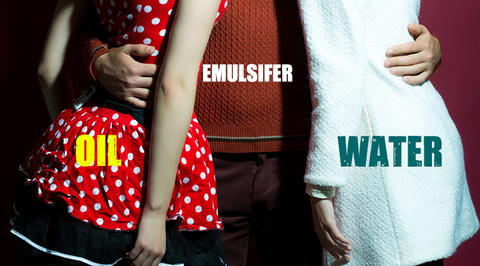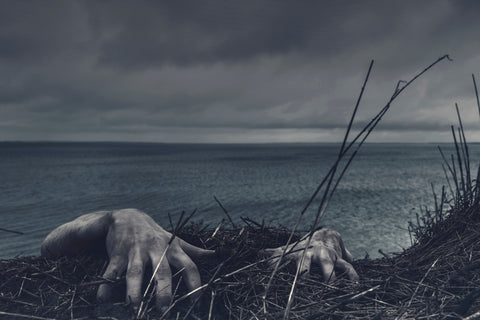What exactly does lotion do?
You know lotion hydrates your skin. Everyone knows that. But how does it do that? What exactly is this simple cream doing to your body's fleshy wrapping paper?
A Scientific Elixir
First, let's talk about what lotion actually is. Lotion is a oil-in-water basic emulsion. You know how you've heard "oil and water don't mix"? Well, turns out that's a bunch of bull****. You can mix them; you just need something called an emulsifier - a substance which bonds to both oil and water simultaneously. The emulsifier holds water in one hand, and oil in another, creating a chain that allows the entire substance to be uniform.

MONSTER's Dr. Frankenstein's Flesh Revival Cream is an emulsion of water, shea butter, and hemp oil, using stearic acid and stearyl alcohol as emulsifier. That name is not just an homage to one of literature's greatest madmen. It describes what lotion literally does to your skin.
You Are A Zombie - Sorta

So here's something that'll mess with your head if you think about it too much: Your body is sheathed in a layer of dead stuff. Yep, the outer layer of your flesh is super mega dead skin cells. This is why it's easy for it to get dried out, cracked, even flaky (think about it - your organs don't sometimes get "flaky" - just the outermost layer of your body).
This outer layer is called your epidermis. It starts somewhere around 1/3 of an inch below the surface. At the bottom are healthy, living skin cells. They reproduce, live happy and productive lives, and then they die. Before the end, they start to produce a fibrous substance called keratin to get it ready to turn into your body's thin, dead armor. As the cells at the top die, they are scraped off (either by cleaning, exfoliating, or just good old-fashioned erosion), which pushes the lower cells to the top. When they get there, they are dead cells that act almost like scales. So your skin is part zombie, part lizard. You are one weird, wicked monster.
Good news is, the keratin, and the fact that these cells are dead, makes this outer skin layer good as a protective coating for your body. But unlike the rest of your body, which is nourished mostly by the moisture and nutrients in your blood, this layer of hairy death requires a bit of care from you. There are several primary methods of doing this, including cleaning, exfoliation, and maintaining a healthy diet to keep your skin's lifecycle healthy. But here we're going to focus on the main function of lotion: Hydration.
Soaking the Death Armor
Cleaning your skin is vital to good skin care, but there's a downside. Soaps and other cleaners (surfactants) work by allowing your skin's natural oils - which are full of dirt and dead skin - to bond with water, making them easy to wash away. This means the sebum oil that your skin produces, and which normally keeps it moisturized, is being stripped away. You're essentially creating one problem by solving another.
The solution is to replace that natural moisture with something else. This is where lotion comes in. When you slather it on, the lotion soaks into your skin, and the water and oil hydrate those dry, dead cells. This reduces irritation caused by dry skin, makes it look more supple and lively, and generally makes it feel better. Like the name of our Flesh Revival Cream implies, in a way, lotion helps to bring that skin back to life.

Welcome back.
A good lotion also helps to create a protective barrier to seal in the moisture it provides. This defends against environmental factors like extreme temperatures or wind that can cause your skin to get dryer than in optimal conditions. To know how well your lotion will protect your skin, you need to know a little about the ingredients that are used in lotions.
The Good Stuff
Water: In every lotion, water is the first ingredient you'll see. For "creams" you may find another ingredient listed first, and they are thicker and have lower percentages of water, but even in those, you'll probably see water first. And why not? Not only do oil-in-water emulsions like lotion work best with high water content, but for hydration, you can't beat water. I mean it's right there in the word (hydro meaning water).
Oil: Cheaper lotions will use a lot of glycerine (which is a humectant, and functions kind of like an oil but not really), and petrolatum, aka petroleum jelly or mineral oil. These will do the trick, but there are much healthier oils for your skin that will give you better results. Look for shea butter, coconut oil, hemp oil, or jojoba oil. Some would add olive oil to the list, but there are a lot of different grades of olive oil, and in that $5 bottle from the drug store, you're not getting extra virgin. You're getting lower grade pomace oil, which is way cheaper for manufactures and keeps that bottom line low at the cost of quality.
Dr. Frankenstein's Flesh Revival Cream uses hemp oil and shea butter.
Hemp oil is rich in omega-6 fatty acids, which act as an anti-inflammatory and also encourage healthy skin growth and cell generation. The omega-6 and omega-3 fatty acids are sweet nutrients that can help soothe and treat atopic dermatitis. The linoleic and oleic acids have an "anti-aging" effect on skin as well, making it great for perking up that layer of dead skin you've got draped over your body meat.
Butter: Shea butter is our other primary ingredient. Technically it's not an oil, but it functions much like one in cosmetic products like lotion. It also has anti-inflammatory properties, and helps soften your skin. It also does a wicked fine job of creating a barrier to lock in moisture and keep that lotion working longer.
Glycerine: Vegetable glycerine is a very versatile substance that is used in a ton of personal care products. It's soluble in water and works well in emulsions. It's what's called a humectant - it draws in moisture, even from the air around it. On your skin, as part of a lotion, this adds hydration and extends the usefulness of lotion so you don't have to apply it as often. Under normal conditions, our lotion should only need to be applied once daily, or even every other day. If you're a coal miner or a deckhand or something though, you'll probably need to use it more often.
Beyond those basic ingredients, you'll see other stuff in lotion. As mentioned above, they all have an emulsifier (stearic acid, cetyl alcohol, and ceterayl alcohol are common). You'll also see thickeners like lecithin, carbomer, etc. Vitamins are common as well, though vitamin E is the main one you need to be concerned about with skincare, and is found in high concentrations in skin-healthy oils. Most have some kind of fragrance too. That doesn't really do much for your skin; it just smells nice.
A Flesh Revival Cream
Taking care of your skin is one of the most basic self-care practices, and one that can make a world of difference for your health and hygiene. Dudes often make the mistake of neglecting their skin, even going so far as to consider the practice effeminate. F*** that noise. Take care of your skin, because that dried out husk of death armor is the thin, fleshy line that protects your whole body from the evils of the world.


